Handgunners ahve embraced the idea of optics wholeheartedly. Optic-readiness has become the new Picatinny rail…you might not use it, but you probably want it on your gun.
Red dots have moved from duty-sized guns to the microcompact market. Shield kicked it off, but companies like SIG, Bushnell, Holosun, and Riton have followed suit. We got hands-on with the latest Riton mini red dot, the Riton 3 Tactix MPRD 2.
For the sake of brevity, let’s call it the MPRD 2. What does MPRD stand for? Well, the MRPD product page doesn’t really say, but the MRPD 1 product page spells the acronym out…Micro Pistol Red Dot. Regardless of what it stands for, it’s designed for handguns. Any that with the famed Shield RMSc footprint.
One of the things I’m grateful for is that micro red dots don’t have as much footprint drama as standard pistol red dots. Most seem to have agreed on one, besides Trijicon. The Shield footprint effectively rules the market. I mounted the Riton to my new P365-XMacro series and have given it the old one-two punch.
Features
Riton is something of a newcomer to this world. More recently, they’ve become fairly well known for their magnified optics, but they offer a line of affordable red dots, too. This includes rifle red dots, a magnifier, and a few different handgun options. The MRPD 2 is a simple optic, but offers a few features that make it attractive, especially at its price point.
In the past, we’ve seen a lot of optics with polymer lenses and polymer bodies in the micro red dot category. Riton uses real glass, as well as a 6061 aluminum housing in the construction of the optic. That’s surprisingly rare for such an affordable optic.
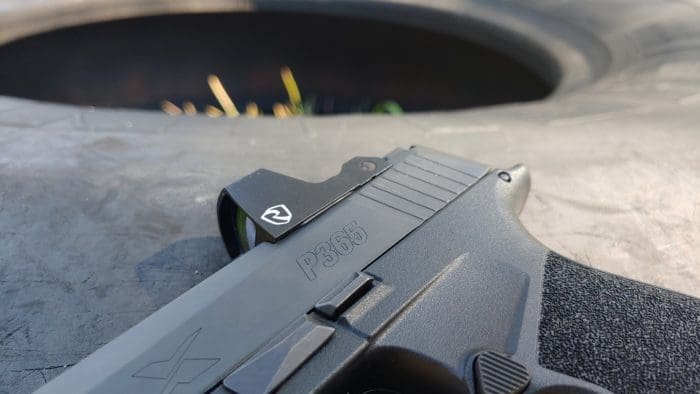
The MPRD 2 is button-free. It comes on when moved and shuts off automatically after it remains stationary for three minutes. Never has the MPRD 2 failed to pop on for me when grabbed or moved. It’s also hard to catch it shut off because the slightest movement will flip it back on. However, I managed to catch it turning off a time or two.
Brightness adjustment is automatic and it reacts to the environment it’s in and the ambient light it picks up. It adjusts quickly, and the adjustments work in the brightest part of a sunny Florida day down to the point of being NVD-compatible. As well as the Riton adjusts, I prefer to be in control of my brightness on a defensive firearm.
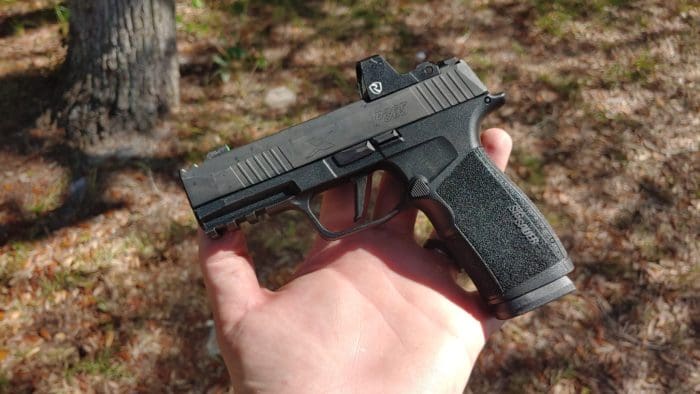
The optic has a 3 MOA red dot and will last up to 50,000 hours on a single CR2032 and the battery installs in the bottom of the optic. When it dies, you’ll have to remove the optic to swap batteries, which means you’ll have to re-zero the optic when you swap batteries.
On Brightness
My main issue with the auto-adjusting feature is that it doesn’t take into account light differences in an environment. If I’m inside a building, aiming at a target outside in the sunlight, the dot adjusts for the inside ambient light, and it appears dim against the brightly lit outdoors.
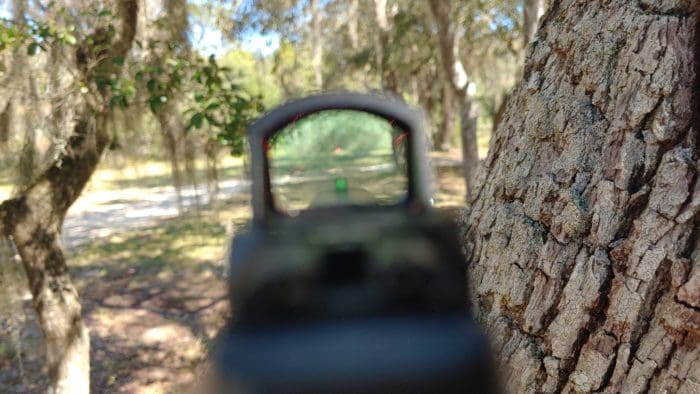
Weapon or handheld lights can have the same effect to a lesser degree. If the light’s bright and the environment tight, it reflects enough to compensate. For wide-open outdoors, it tends to wash out against a bright enough light.
At the Range
Installing the MPRD 2 requires nothing more than a couple of include screws, an Allen wrench, and some common sense. Loc-tite should absolutely be applied if you like your optics to remain mounted. The manual lists 12 inch/pounds for the screws, but I don’t have a torque tool that small, so I applied a healthy dose of muscle with a degree of common sense to lock it down.
In walking from indoors to outside, I noticed the dot adjusts very quickly to the changing environment. It does a great job of adjusting to the light around it and keeping the dot visible and comfortable.
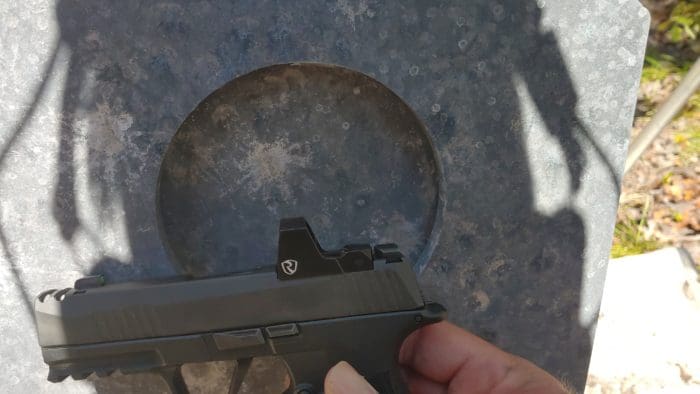
The dot itself is very crisp and perfectly round. I expect a little starburst effect from more affordable red dots, but there wasn’t any here.
The view through the MPRD 2 lens is also nice and clear, with a slight blue tinge that you only notice when you’re looking for it. Once mounted, the manual says to zero at seven yards. I wasn’t in the mood to deal with the math of 1 MOA adjustments at 7 yards, so I moved back to ten to make it a nice round number.
Getting to Zero
I also prefer a 10-yard zero on my red dots. It tends to carry me out to 50 yards easily enough. With the Allen key ready, I fired my three-shot group, observed the impact, measured the distance to the bull’s eye. I did a bit of mental math and went to make adjustments. Here is where things got annoying.
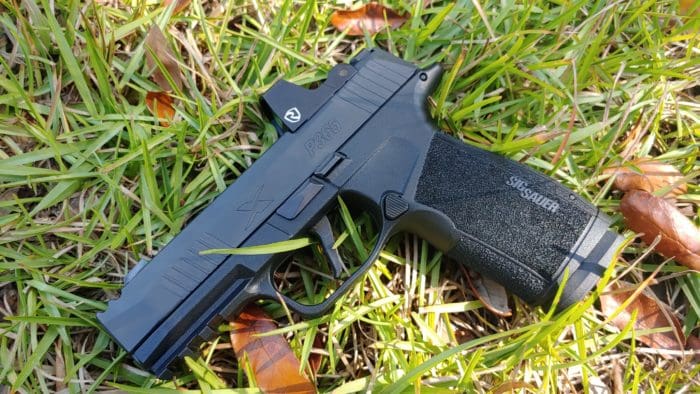
There is no audible click and no distinct tactile detent per adjustment. There might be a faint tactile bump, but it’s difficult to feel.
I might have imagined the whole thing, to be honest. To try to make up for the lack of knowing how many adjustments I made, I moved conservatively. Luckily I only had to make minor adjustments. It took nine rounds total to get me zero’d, not counting my second string of confirmation fire.
Ringing Bells
Once zero’d, my frustration with the adjustments was gone. I just love how easy a red dot makes shooting a pistol. The XMacro isn’t small, but it’s not a full-blown competition pistol like the LS Edge either. I could hit a target at 50 yards like I was a hunchback in a bell tower.
That target is an IPSC-sized target, but I still count it as a win, especially offhand. I cleared my gong rack of targets from four to ten inches at 20 yards in less than five seconds. That pesky 4-inch gong presented the biggest challenge, but I could hit it consistently. After a day of shooting in the sun, the MPRD 2 didn’t give up the ghost or lose zero.
I learned that the combination of dirty ammo + a compensated barrel leaves a bunch of crud on the external lens of an optic, but that didn’t prove to be a problem.

It hung on, and I even dropped it numerous times to see if I could rock it out of orbit. The MPRD 2 remained zero’d and ready to rock. All in all, the little budget optic is fairly impressive and would be a great choice on a plinker or training pistol.
As far as defensive use goes, as I said earlier, I prefer being able to control the brightness of the dot, but I don’t have any other reason not to choose the Riton. It proved durable, accurate, and capable of holding zero and of taking punishment.
Specifications: Riton 3 Tactix MPRD 2 Red Dot Sight
Click Value: 1 MOA
Length: 1.6 inches
Width: .98 inches
Weight: .6 ounces
Battery: CR2032
Battery Life: 50,000 hours average rating
MSRP: $349.99 (about $150 retail)
Ratings (out of five stars):
Reliability * * * *
In terms of general reliability, it works well with no complaints. The only slight reliability issue comes down to varying brightness levels of an environment. If I’m in a building and aiming at a target outdoors, the dot doesn’t adjust for the illumination level of the target or the brightness of something like a weapon-mounted light in certain environments.
Clarity * * * *
It’s a mini red dot and the glass isn’t providing a magnified view, so it gets off easy. The glass lens is nice and clear, with a slight blue tint. It’s not as clear as the Shield RMSc, so one star off.
Ease of Use * * *
The lack of any audible or tactile clicks makes it a pain to zero. I was lucky that it was fairly close to zero’d upon installation. If you had to make broad adjustments, it might start to feel like guesswork. I’d also prefer a manual way to control brightness levels.
Overall * * * *
When I factor in the street price, the performance, and the materials used to create the optic, it scores high. It’s not perfect and I think it’s best on training and plinking guns. Heck, it’s well suited to a steel challenge gun. In the mini optics space, it may very well be the best bang for your buck.
